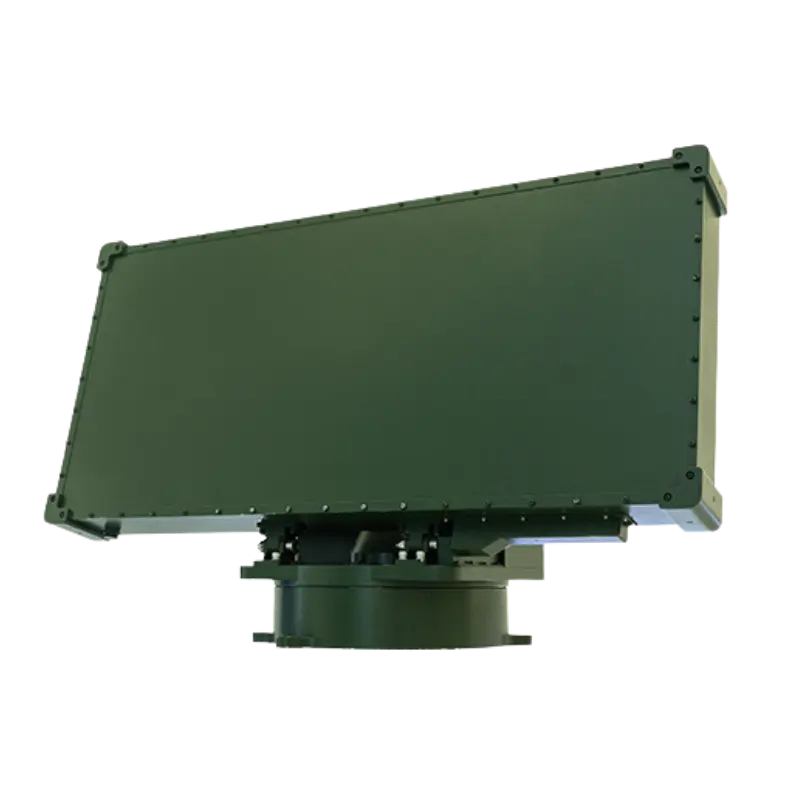Features of YFR-13 Bird Radar Airport
Industry-specific optimization: Algorithm optimization for bird and drone targets can identify bird group movement patterns (such as V-formation) and drone maneuvering characteristics.
High-precision DBF technology: D/E type adopts DBF, which significantly improves multi-target resolution and avoids the false reporting of bird groups as a single target.
Airport compatibility: Complies with civil aviation electromagnetic compatibility standards to avoid interference with airport communication/navigation equipment.
Powerful drone detection radar and bird radar system: Acoustic bird repellent equipment or laser interception system can be integrated to form a “detection-warning-disposal” closed loop.
Overview

With the combination of pulse Doppler + three-coordinate + DBF technology, YFR-13, an advanced avian radar has achieved a comprehensive breakthrough in accuracy, speed and function in the field of airport bird strike prevention,
and is particularly suitable for modern aviation safety scenarios that have high requirements for low-altitude small targets. Its modular design can also be extended to the military and ecological fields, making it a “jack of all trades” for low-altitude monitoring.

Multi-band and DBF technology optimization
X-band (C/E type): Balanced detection distance (5-8km) and resolution, strong anti-rain attenuation capability, suitable for all-weather airport monitoring.
Ku-band (D type): Higher accuracy (azimuth/pitch ≤ 0.3°), but the detection distance is slightly affected by weather (≥ 7km), suitable for high-precision bird flock tracking.
DBF (digital beam forming) technology (D/E type): Multi-beam synchronous processing, improves multi-target tracking capabilities, and adapts to dense bird flocks or drone swarms.
Long detection range (5-8km)
The coverage for typical drones (such as the DJI Phantom 4) is 5-8km, which fully meets the monitoring needs of airport clear areas (usually a radius of 6km).
High accuracy positioning
The highest accuracy is ≤0.3° (D/E type), which can distinguish between birds and drones flying adjacent to each other.
The distance error is ≤8m, ensuring accurate reporting of the target position.
Fast data update
The data rate is 2-3 seconds, which is better than traditional bird radar (usually 5-10 seconds), and can track fast-moving bird flocks in real time.
Pulse Doppler + three-coordinate positioning
The use of pulse Doppler technology can effectively distinguish low-altitude slow targets (such as drones and bird flocks) from ground clutter and improve the detection signal-to-noise ratio.
Azimuth mechanical scanning + pitch phase scanning
360° mechanical rotation: achieve omnidirectional coverage and monitor the airspace around the airport without blind spots.
Pitch electronic phase scanning (DBF technology): quickly adjust the beam pointing and improve multi-target tracking capabilities (YFR-13D/E uses digital beamforming DBF, which has higher accuracy).
Features
Specifications
| Specifications | YFR-13C | YFR-13D | YFR-13E | |
|---|---|---|---|---|
| Radar band | X | ku | X | |
| Technical system | / | DBF | DBF | |
| Scanning method | Azimuth scanning + pitch scanning | |||
| Detection range | Typical target (DJI Phantom 4) | ≥5km | ≥7km | ≥8km |
| Coverage | Azimuth | 0°~360° | 0°~360° | 0°~360° |
| Pitch | 0°~30° | 0°~30° | 0°~30° | |
| Detection accuracy | Distance | ≤8m | ≤8m | ≤8m |
| Azimuth | ≤0.5° | ≤0.3° | ≤0.3° | |
| Pitch | ≤0.5° | ≤0.3° | ≤0.3° | |
| Data rate | 3s | 2s | 2s | |
| Target capacity | ≥500 batches | ≥500 batches | ≥500 batches | |
| Weight | ≤66kg | ≤85kg | ≤100kg | |
| Size | ≤980×450×650(mm) | ≤760×450×870(mm) | ≤1050×430×950(mm) | |
| Power consumption | ≤400W | ≤800W | ≤1500W | |
| Installation method | Fixed/Vehicle | Fixed/Vehicle | Fixed/Vehicle | |
